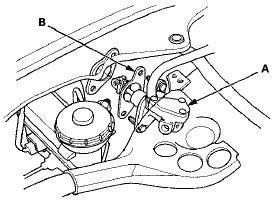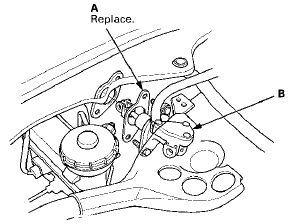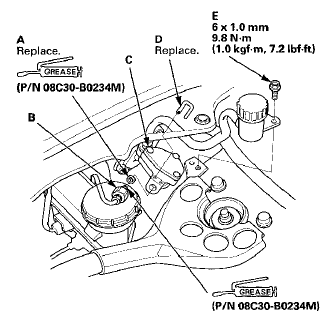 Honda Accord: Clutch Master Cylinder Replacement
Honda Accord: Clutch Master Cylinder Replacement
NOTE: - Use fender covers to avoid damaging painted surfaces.
- Do not spill brake fluid on the vehicle; it may damage the paint or plastic. If brake fluid does contact the paint or plastic, wash it off immediately with water.
1. Remove and discard the brake fluid from the clutch master cylinder reservoir with a syringe or other suitable device.
2. Pry out the lock pin (A), and pull the clevis pin (B) out of the clevis. Remove the master cylinder mounting nuts (C).

3. Remove the reservoir mounting bolt (A) and the retaining clip (B), then disconnect the clutch line (C) from the clutch master cylinder (D), and remove the O-ring (E). Plug or wrap the end of the clutch line with a clean shop towel to prevent brake fluid from coming out.

4. Remove the master cylinder (A) and the clutch master cylinder seal (B).

5. Install a new master cylinder seal (A), then install the master cylinder (B).

6. Install a new O-ring (A) on the clutch line (B), then install the clutch line in the clutch master cylinder (C) with a new retaining clip (D). Install the master cylinder reservoir mounting bolt (E).
NOTE: - Apply silicone grease (P/N 08C30- B0234M) to the O-ring and the end of the clutch line.
- Make sure not to get any silicone grease on the terminal part of the connectors and switches, especially if you have silicone grease on your hands or gloves.

7. To prevent the retaining clip (A) from coming off, pry apart the tip of the ciip (B) with a screwdriver.

8. Make sure the hose clamps (A) are positioned on the master cylinder (B) and reservoir (C) as shown.

9. Install the master cylinder mounting nuts (A).

10. Apply multipurpose grease to the clevis pin (B) and the mating surfaces (C) of the clevis and the pedal.
Slide the clevis pin into the clevis, then install the lock pin (D).
11. Bleed the clutch hydraulic system (see page 12-6).
12. Adjust the clutch pedal, the clutch pedal position switch, and the clutch interlock switch (see page 12-7).
13. Check the clutch operation, and check for leaks.
14. Test-drive the vehicle.
 Clutch Pedal Assembly Replacement
Clutch Pedal Assembly Replacement
1. Disconnect the clutch pedal position switch connector
(A) and the clutch interlock switch connector (B).
2. Pry out the lock pin (C), and pull the clevis pin (D) out
of the clevis.
3. Remov ...
 Slave Cylinder Replacement
Slave Cylinder Replacement
NOTE:
- Use fender covers to avoid damaging painted
surfaces.
- Do not spilt brake fluid on the vehicle; it may damage
the paint or plastic. If brake fluid does contact the paint
or plastic, wa ...
See also:
ATF Level Check
NOTE:
-Keep all foreign particles out of the transmission.
-Check the ATF level within 60—90 seconds after
turning the engine off.
-Higher ATF level may be indicated if the radiator fan
...
Paint Code
...
ATF Cooler Hose Replacement
Exploded View
NOTE: When installing the hose clamps, make sure they do not interfere with
the surrounding parts.
1. Install the ATF cooler hoses over the ATF cooler lines with the clips at
a ...
